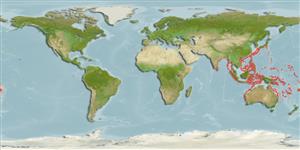>
Acropomatiformes (Oceanic basses) >
Synagropidae (Splitfin ocean-basses)
Etymology: glossodon: Name from Greek 'glossa' for tongue and 'odous' for teeth, referring to the teeth on the tongue, the main diagnostic character of this species...
Environment: milieu / climate zone / depth range / distribution range
Sinh thái học
Biển Tầng đáy biển sâu; Mức độ sâu 156 - 320 m (Ref. 116586). Tropical
Western Pacific: Philippines and around Indonesia, north to Taiwan and south to northern Australia; with a single specimen caught in eastern Indian Ocean, off Myanmar.
Bộ gần gũi / Khối lượng (Trọng lượng) / Age
Maturity: Lm ? range ? - ? cm
Max length : 9.0 cm SL con đực/không giới tính; (Ref. 116586)
Short description
Hình thái học | Sinh trắc học
Các tia vây lưng cứng (tổng cộng): 10; Các vây lưng mềm (tổng cộng): 9; Tia cứng vây hậu môn 2; Tia mềm vây hậu môn: 7. This moderately deep-bodied species is distinguished by the following characters: convex dorsal head profile; A II + 7; pectoral-fin rays 14-16 rays with pectoral length 24-28.5% SL; gill rakers 16-20; pseudobranchial filaments broad 15-25, increasing with size; first anal-fin pterygiophore is long, straight and slender, with narrow, hollow tip; vomer broad, triangular, rounded posteriorly, and with many granular teeth; palatine and ectopterygoid with 2-4 rows of granular teeth; tongue with long central band of densely packed granular teeth; orbital diameter 11.7-13.3% SL; absence of longitudinal ridges on preopercular lobe; otolith compact (OL:OH = 1.6-1.7) (Ref. 116586).
This species was observed and collected in association with the Sakura shrimp, Lucensosergia lucens (Hansen, 1922) in Taiwan during fishing season (December-May) in mid-water trawls, together with Parascombrops yamanouei and other pelagic fishes like bregmacerotids and surface-migrating myctophids. In the Arafura Sea, it was collected in association with demersal fishes like Acropoma japonicum Günther, 1859, Malakichthys levis Yamanoue & Matsuura, 2001, Owstonia aff. Pectinifer (Myers, 1939) and Bembrops spp. at depth close to sea bottom but not far from a major drop-off. (Ref. 116586).
Life cycle and mating behavior
Chín muồi sinh dục | Sự tái sinh sản | Đẻ trứng | Các trứng | Sự sinh sản | Ấu trùng
Schwarzhans, W.W. and A.M. Prokofiev, 2017. Reappraisal of Synagrops, Günther, 1887 with rehabilitation and revision of Parascombrops Alcock, 1889 including description of seven new species and two new genera (Perciformes: Acropomatidae). Zootaxa 4260(1):1-74. (Ref. 116586)
IUCN Red List Status (Ref. 130435)
Threat to humans
Harmless
Human uses
Thêm thông tin
Tên thường gặpCác synonym ( Các tên trùng)Trao đổi chấtCác động vật ăn mồiĐộc học sinh tháiSự tái sinh sảnChín muồi sinh dụcĐẻ trứngTổng số cá thể đẻ trứngSự sinh sảnCác trứngEgg development
Age/SizeSự sinh trưởngLength-weightLength-lengthLength-frequenciesSinh trắc họcHình thái họcẤu trùngSự biến động ấu trùngBổ xungSự phong phúBRUVS
Các tài liệu tham khảoNuôi trồng thủy sảnTổng quan nuôi trồng thủy sảnCác giốngDi truyềnElectrophoresesDi sảnCác bệnhChế biếnNutrientsMass conversion
Các công cụ
Special reports
Download XML
Các nguồn internet
Estimates based on models
Phylogenetic diversity index (Ref.
82804): PD
50 = 0.5001 [Uniqueness, from 0.5 = low to 2.0 = high].
Bayesian length-weight: a=0.00955 (0.00424 - 0.02152), b=3.02 (2.82 - 3.22), in cm total length, based on LWR estimates for this (Sub)family-body shape (Ref.
93245).
Mức dinh dưỡng (Ref.
69278): 3.4 ±0.5 se; based on size and trophs of closest relatives
Fishing Vulnerability (Ref.
59153): Low vulnerability (10 of 100).
